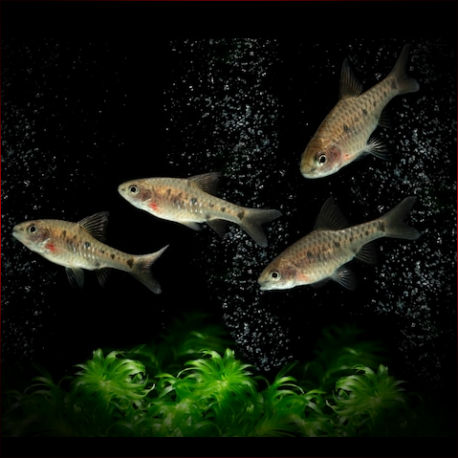More info
Datasheet
| Minimum Tank Size | 90 litres / 23.78 US gallons |
| Maximum Size | 5.5cm / 2.17inches |
| Temperature | 16°C / 60.80°F - 24°C / 75.20°F |
| Hardness | 2.02dgH / 36ppm - 12.05dgH / 215ppm |
| pH | 6.0-7.5 |
Behaviour:
The Shalyni Barb is known to be very peaceful, but due to its preference for cooler temperatures, it may not be the best choice for a general community aquarium. In nature, this species tends to associate with fishes inhabiting similar biotopes, especially comparably-sized cyprinids like open water-dwelling species. Suitable tankmates can also include balitorid, cobitid, and nemacheilid loaches, as well as benthic cyprinids such as Crossocheilus and Garra species. Being a schooling species by nature, it is recommended to keep at least 6-10 specimens together, which not only decreases skittishness but also encourages the development of better colors in males due to the presence of conspecific rivals.
Feeding and Diet:
In the wild, Shalyni Barbs are likely foragers, feeding on diatoms, algae, organic detritus, small insects, worms, crustaceans, and zooplankton. In the aquarium, they are easily fed but thrive on a diet of small live and frozen foods like bloodworms, Daphnia, and Artemia, along with high-quality dried flakes and granules. Including foods with additional plant or algal content in their diet is beneficial for their condition and coloration.
Reproduction & Dimorphism:
Information regarding the reproduction of the Shalyni Barb is currently unreported. Adult males of this species exhibit noticeable sexual dimorphism, being smaller, slimmer, and more colorful compared to females, especially during the spawning season.
Habitat and Distribution:
Shalyni Barbs, scientifically known as Pethia Shalynius, are benthopelagic fish primarily found in streams and minor tributaries at altitudes exceeding 1200 meters above sea level. They inhabit cool, clear, well-oxygenated waters with substrates consisting of bedrock, boulders, cobbles, and gravel. Although aquatic plants are typically absent, riparian vegetation may be well-developed in their habitat. These barbs are also present in ponds, small lakes, and some stagnant water bodies with muddy substrates. The species is endemic to Meghalaya, India, with its type locality being Barapani Lake in the Khasi Hills. However, industrial activities in the region pose a threat to their population, with historical misidentifications reported in Assam.
Aquarium Setup:
To exhibit their best coloration, Shalyni Barbs thrive under dim lighting and are ideal for heavily planted aquariums with a dark substrate or setups mimicking a flowing river or stream. Decorate their tank with variably-sized rocks, gravel, driftwood branches, and plants such as Microsorum, Bolbitis, or Anubias spp., which can be attached to the decor. As the species naturally inhabits running water, it is crucial to maintain stable water conditions. Regular water changes of 30-50% of the aquarium volume each week are recommended for their well-being.
For details, see the table provided.

